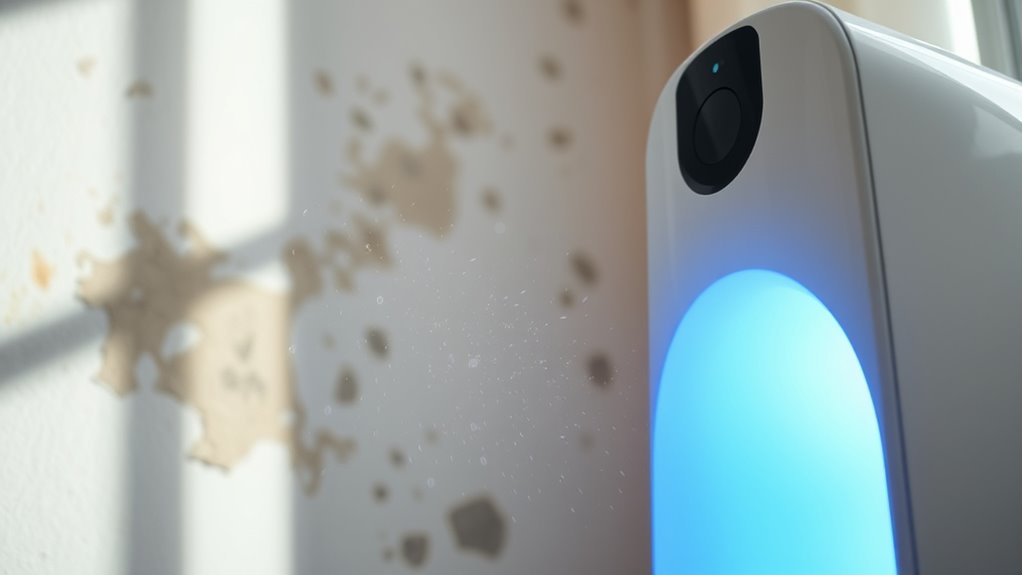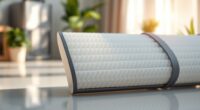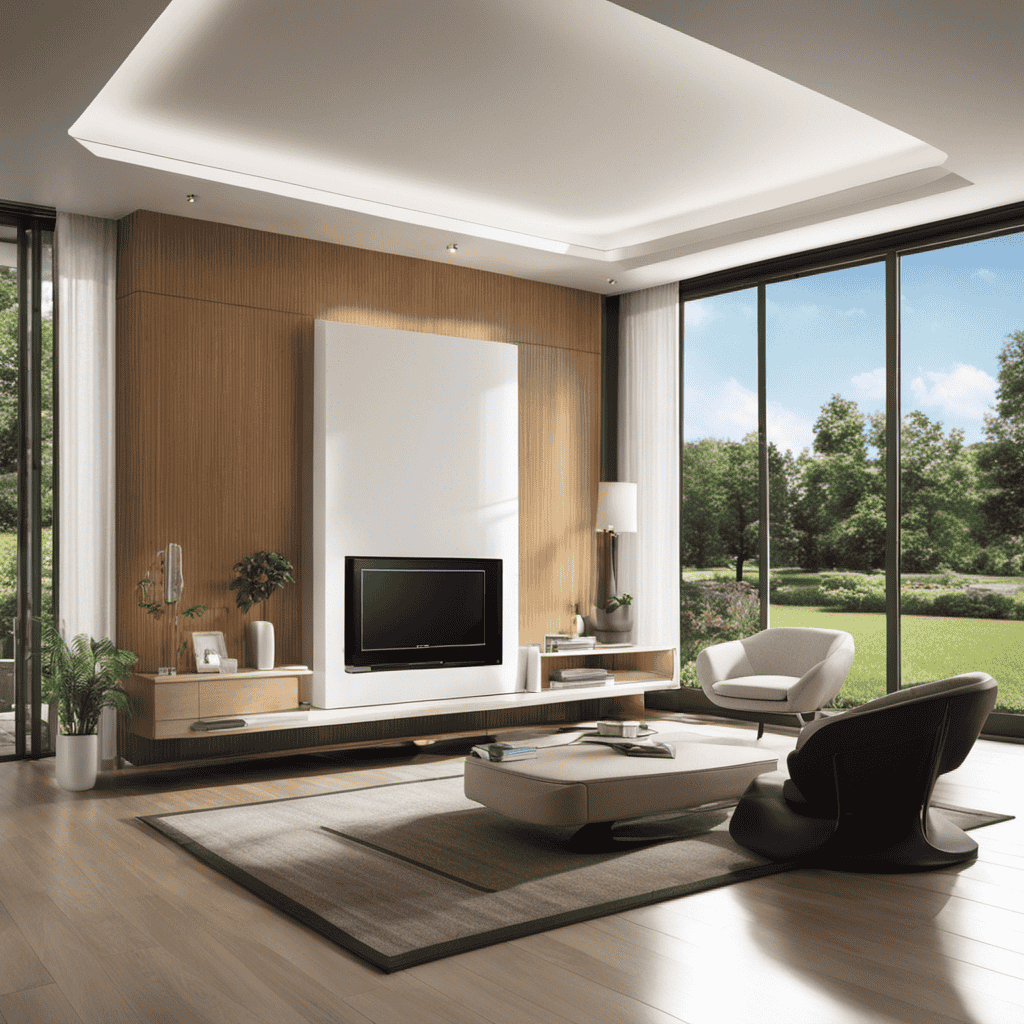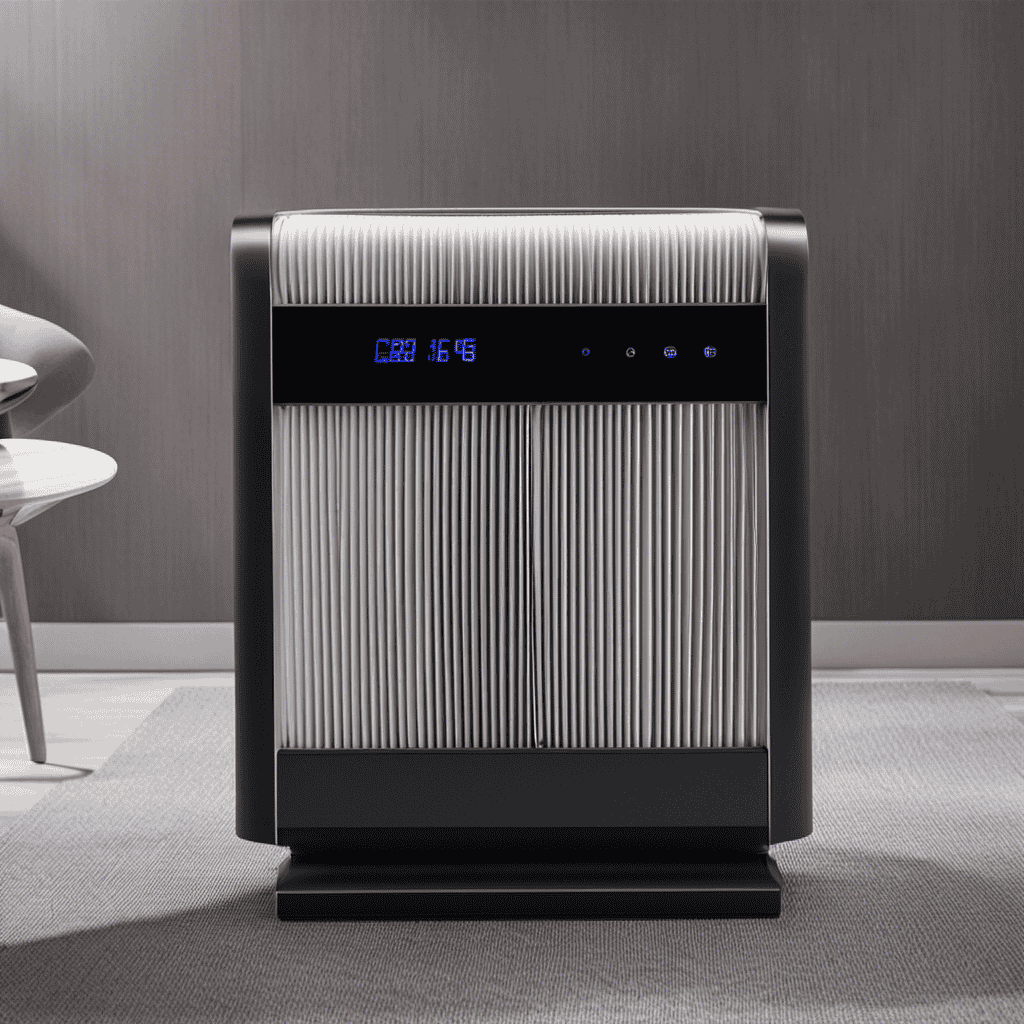Air purifiers with HEPA filters effectively capture mold spores as small as 0.3 microns, reducing their presence in your indoor air. Combining HEPA with UV sterilization destroys spores at a molecular level, preventing growth. Activated carbon filters also remove mold odors and VOCs. Proper placement, maintenance, and humidity control enhance these benefits, creating a healthier environment. To find out how different technologies work together, explore the details that can make a real difference in your home’s air quality.
Key Takeaways
- HEPA filters capture tiny mold spores (0.3 microns), significantly reducing airborne mold particles indoors.
- UV sterilization destroys mold spores at a molecular level, preventing their growth and spread.
- Activated carbon filters absorb mold odors and VOCs, improving overall air quality and indicating mold presence.
- Proper placement and regular maintenance of air purifiers ensure optimal removal of mold spores from indoor air.
- Combining filtration technologies with humidity control creates an effective barrier against mold proliferation indoors.
Understanding Mold and Mildew in Indoor Environments
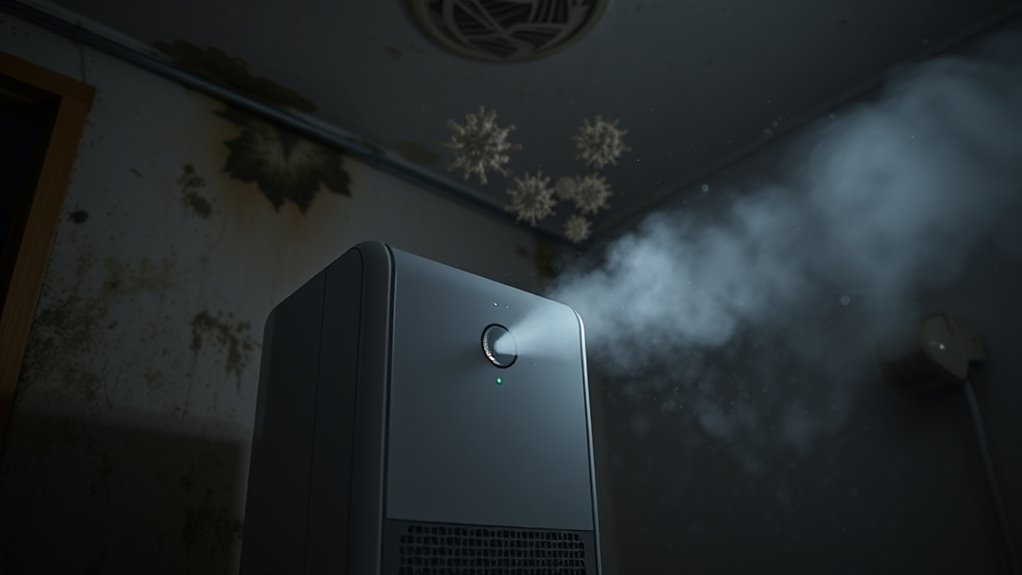
Mold and mildew thrive in damp, poorly ventilated indoor spaces, often going unnoticed until they cause visible damage or health issues. Mold growth occurs when moisture levels are high, providing an ideal environment for spores to settle and multiply. To prevent this, mildew prevention focuses on controlling humidity and reducing wetness around your home. Fix leaks promptly, use exhaust fans in bathrooms and kitchens, and keep indoor humidity below 60%. Regularly inspect hidden areas like behind furniture, under sinks, and in basements for signs of mold or mildew. Proper ventilation plays a crucial role in air circulation, which helps reduce moisture buildup and inhibits mold growth. Adequate ventilation systems are essential for maintaining a dry indoor environment and preventing mold spores from spreading and causing problems. By understanding how moisture fuels mold growth, you can take proactive steps to keep your environment dry and safe, reducing the chances of mold spores spreading and causing problems. Additionally, using an air purifier with HEPA filtration can help capture airborne mold spores, further reducing indoor mold levels and improving air quality.
How Mold Spores Affect Indoor Air Quality

Mold spores can quickly circulate in your indoor air, affecting your health and comfort. Breathing in these spores may trigger allergies, asthma, or other respiratory issues. They also compromise your indoor environment, making it less safe and less pleasant to be in. Utilizing an air purifier equipped with HEPA filters can effectively capture airborne mold spores and improve overall air quality. In addition, automation in business has led to innovations in air purification systems, enhancing their ability to detect and eliminate airborne contaminants.
Health Risks From Spores
Have you ever wondered how tiny spores floating in the air can impact your health? Mold spores can trigger allergic reactions, causing symptoms like sneezing, coughing, and itchy eyes. For those with asthma or respiratory issues, inhaling these spores can worsen breathing problems and lead to frequent flare-ups. Prolonged exposure may even increase your risk of developing respiratory infections or chronic conditions. Mold spores are especially dangerous for sensitive individuals, such as children, the elderly, or immunocompromised people. By reducing airborne mold spores, air purifiers help protect your respiratory health, minimizing allergy symptoms and preventing more serious health complications. Incorporating air filtration technology into your home can significantly improve indoor air quality by actively removing spores and other pollutants. Proper ventilation methods are also essential in dispersing moisture and preventing mold growth, further enhancing your indoor environment. Using an air purifier with HEPA filters is particularly effective, as these filters can capture 99.97% of tiny spores and particles present in the air. Keeping spores at bay creates a healthier indoor environment, allowing you to breathe easier and feel more comfortable in your home.
Impact on Indoor Environment
Indoor air quality can be substantially affected when mold spores become airborne, introducing pollutants that degrade the environment you live in. These spores can settle on surfaces or circulate, reducing air freshness and potentially triggering allergies. To improve your indoor environment, effective ventilation strategies are essential. They help remove airborne spores and circulate fresh air, preventing mold growth. Additionally, humidity control plays a crucial role; keeping humidity levels below 60% discourages mold proliferation and reduces spore release. Proper ventilation combined with humidity management minimizes mold spores in the air, creating a healthier space. Using air purifiers further enhances this process by filtering out airborne spores, ensuring your indoor air remains cleaner and safer to breathe.
The Role of HEPA Filters in Capturing Mold Particles
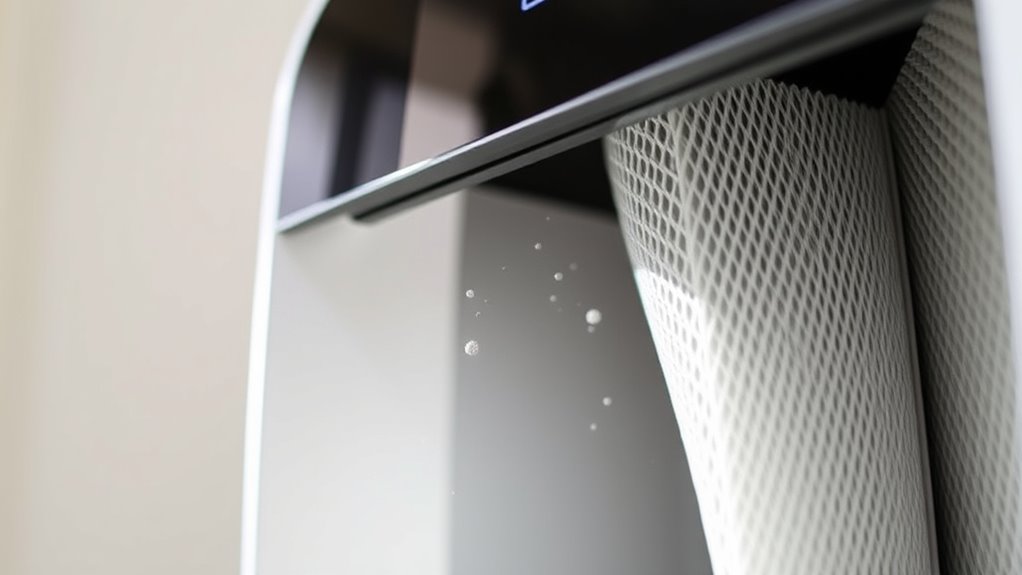
HEPA filters play an essential role in improving air quality by effectively capturing tiny mold particles that can otherwise circulate throughout your space. Their advanced design ensures mold particle capture at a microscopic level, reducing indoor mold spores considerably. When you use an air purifier with HEPA filtration, you’re actively removing airborne mold, which helps prevent allergy symptoms and respiratory issues. The key benefits include:
- Traps particles as small as 0.3 microns
- Enhances overall air cleanliness
- Supports healthier indoor environments
- Reduces mold spore circulation
- Complements other mold prevention methods
- Incorporating HEPA filters also benefits from high efficiency, ensuring maximum removal of airborne contaminants. Additionally, the use of HEPA filters aligns with indoor air quality standards to promote a healthier living space.
Additional Technologies Enhancing Mold Removal
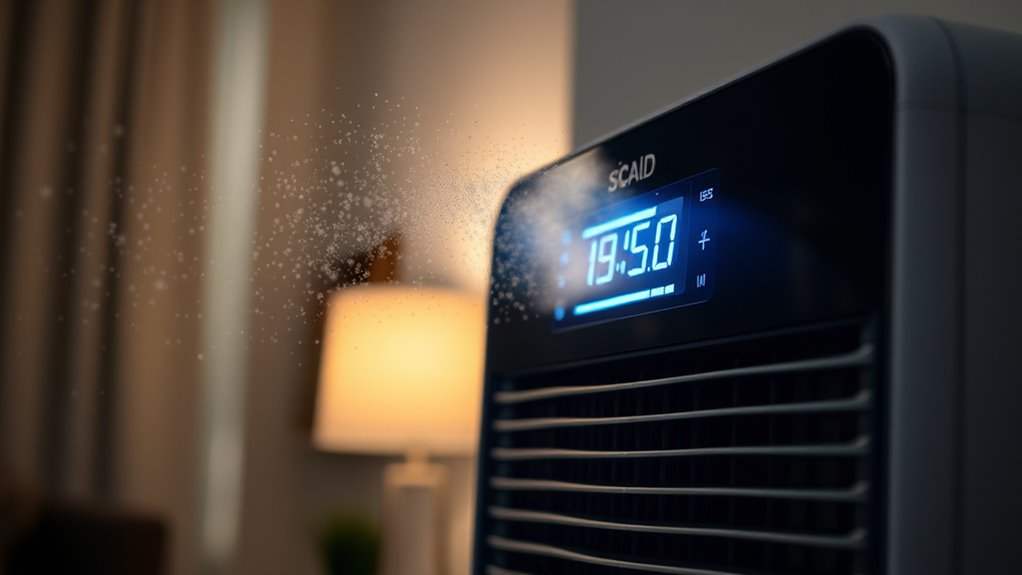
Beyond HEPA filters, several advanced technologies further boost mold removal in air purifiers. UV sterilization is key, as it destroys mold spores at a molecular level, preventing growth and reproduction. Additionally, UV sterilization enhances overall effectiveness by providing a chemical-free method to eliminate mold at its source. Activated carbon filtration also plays an essential role by absorbing mold odors and volatile organic compounds (VOCs) associated with mold, improving air quality. These technologies work together with HEPA filters to create a thorough defense against indoor mold. Here’s a quick overview:
| Technology | Function | Benefits |
|---|---|---|
| UV sterilization | Uses ultraviolet light to kill mold spores | Prevents mold growth and reduces health risks |
| Activated carbon | Absorbs odors and VOCs from mold | Enhances air freshness and odor control |
| HEPA filters | Capture airborne mold particles | Removes visible spores and debris |
Additionally, advancements in air quality monitoring enable users to detect mold spores early, ensuring prompt action to maintain a healthy indoor environment. Modern mold spore level detection techniques allow for more precise and timely responses to potential mold problems.
Choosing the Right Air Purifier for Mold Control
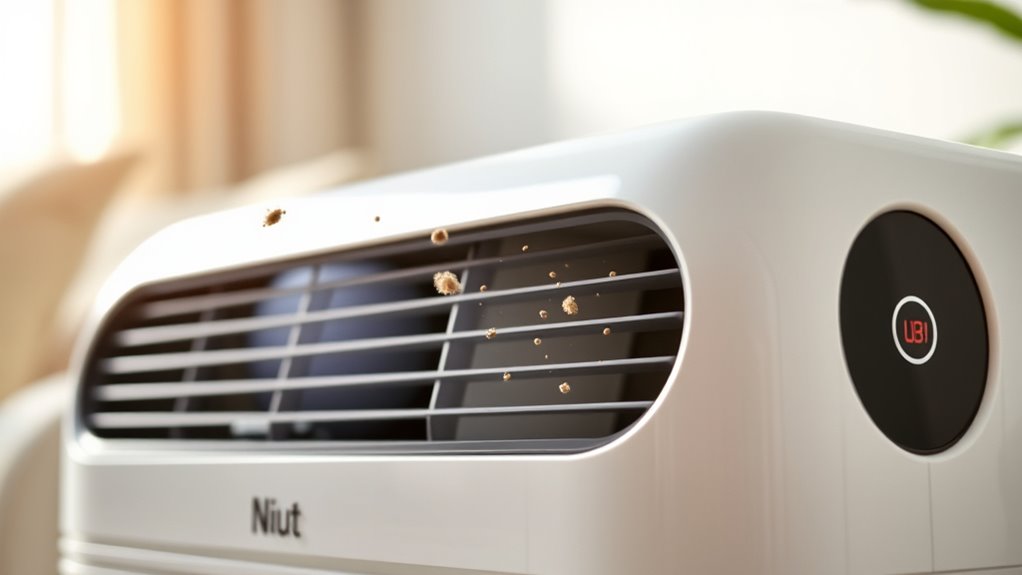
Choosing the right air purifier is essential for effective mold control, as not all models are equally equipped to handle mold spores and related pollutants. Look for units with features like UV light to kill mold spores or activated carbon filters to absorb mold odors and airborne toxins. Consider these key factors:
- HEPA filtration for capturing mold spores
- UV light for microbial inactivation
- Activated carbon for odor and chemical removal
- Suitable room size for ideal performance
- Ease of maintenance and filter replacement
A purifier with UV light can actively kill mold spores, while activated carbon improves air quality by reducing musty smells. Combining these technologies ensures you select a device that effectively targets mold and helps maintain a healthier indoor environment. Proper airflow and ventilation also play a vital role in air quality management, enhancing the overall effectiveness of your mold prevention efforts. Additionally, selecting an air purifier with advanced filtration can further improve its ability to remove tiny mold particles from indoor air, especially when combined with regular cleaning and moisture control.
Proper Placement and Maintenance of Air Purifiers

To maximize the effectiveness of your air purifier in controlling indoor mold, it’s vital to place it in the right spot and perform regular maintenance. Position your purifier in areas prone to moisture and mold growth, such as bathrooms, basements, or near windows. Avoid placing it behind furniture or in corners where airflow is restricted. Use clear placement strategies to guarantee optimal air circulation and mold spore capture. Regular filter maintenance is essential—check, clean, or replace filters as recommended by the manufacturer to keep the device working efficiently. A well-maintained air purifier with proper placement helps reduce mold spores in the air, improving indoor air quality and preventing mold-related issues. Proper care ensures your investment continues to provide effective mold control. Additionally, understanding air circulation can help you optimize purifier placement for better results.
Preventative Measures to Reduce Indoor Mold Growth
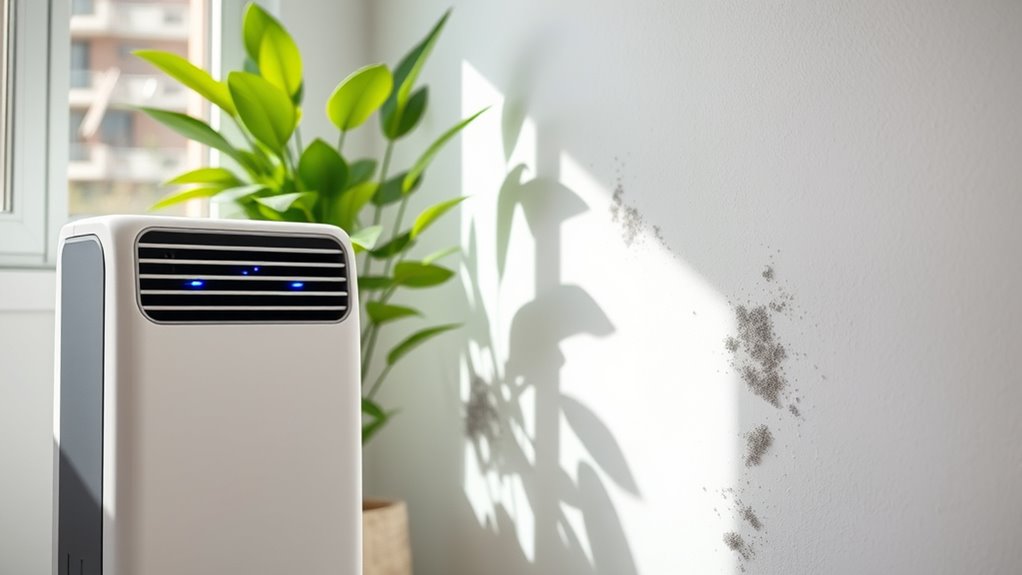
Taking proactive steps to prevent indoor mold growth can substantially improve your home’s air quality and reduce reliance on air purifiers. Start by controlling humidity levels using effective humidification techniques, keeping indoor humidity below 60%. Select mold-resistant materials like mold-resistant drywall and treated wood when renovating or building. Ensure proper ventilation in bathrooms, kitchens, and laundry areas to prevent moisture buildup, and consider installing exhaust fans for added effectiveness. Regularly fix leaks and water damage promptly to stop mold from establishing, as moisture is a key factor in mold development. Additionally, consider using dehumidifiers in damp spaces and improve airflow with fans and open windows. These measures work together to minimize mold-friendly conditions and create a healthier environment. Incorporating moisture control strategies that provide detailed guidance can further enhance your mold prevention efforts, especially by understanding the importance of humidity management in preventing mold growth. For example, understanding how sound vibrations can influence cellular processes may inspire innovative approaches to maintaining a balanced indoor environment. Proper ventilation not only reduces moisture but also helps circulate air, preventing stagnant zones where mold spores could settle and grow.
Benefits of Using Air Purifiers for a Healthier Home
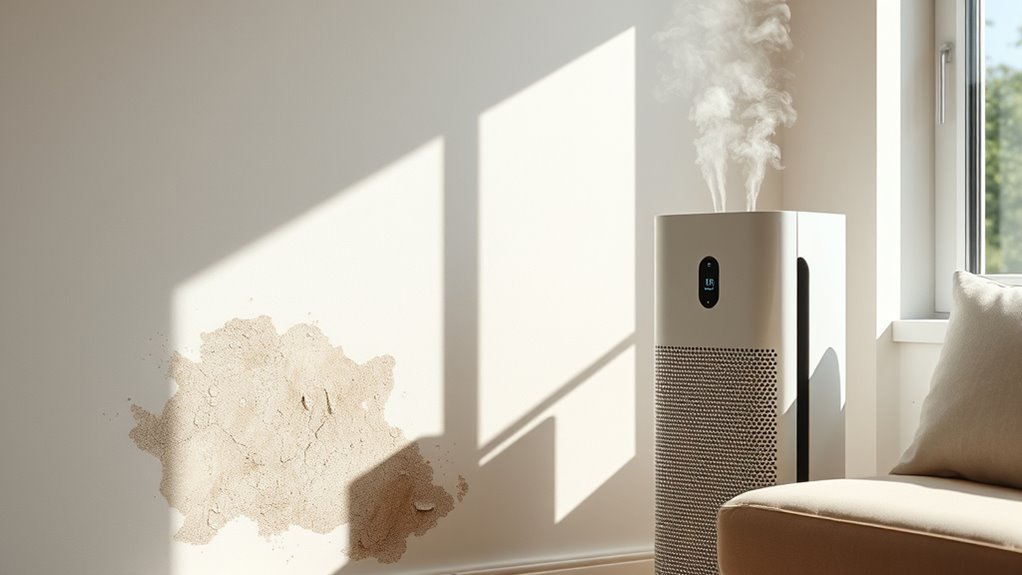
Using an air purifier can substantially improve the air quality in your home, making it fresher and healthier to breathe. It also helps reduce allergens and pollutants that trigger allergy and asthma symptoms. With cleaner air, you’ll notice a more comfortable and safer living environment every day. Proper use of air purifiers can also help decrease indoor mold spores, which are a common cause of respiratory issues and mold-related health problems. Incorporating a purifier with a HEPA filter can effectively capture mold spores and allergens, further enhancing indoor air quality. Additionally, understanding industry trends can help you select the most effective air purifier for your needs. Modern air purifiers often utilize advanced filtration technologies, such as activated carbon filters, to improve overall air cleanliness and combat a wider range of airborne contaminants.
Improved Indoor Air Quality
Have you ever wondered how much cleaner your indoor air could be? Using an air purifier substantially boosts your home’s air quality. It captures mold spores, dust, pet dander, and other pollutants, making your environment healthier. To keep your purifier working efficiently, regular air purifier maintenance is essential. Additionally, following mold prevention tips, like controlling humidity and fixing leaks, helps prevent mold growth. Maintaining proper air quality is vital for overall health and well-being.
Here are some benefits of improved indoor air quality:
- Reduced airborne allergens and irritants
- Fewer mold spores circulating
- Better respiratory health
- Enhanced sleep quality
- A fresher, more comfortable home environment
Investing in proper maintenance and mold prevention creates a safer, cleaner space for you and your family.
Allergy and Asthma Relief
Ever wondered how much relief an air purifier can bring to allergy and asthma sufferers? By improving air quality, it helps remove mold spores and other allergens that trigger symptoms. Effective mold remediation reduces airborne mold, decreasing irritation in your lungs and sinuses. Air purifiers with HEPA filters trap tiny mold spores and dust mites, offering immediate relief during allergy and asthma flare-ups. This creates a healthier environment, making breathing easier and reducing the frequency of attacks. Plus, cleaner air supports overall respiratory health. Using an air purifier isn’t just about removing visible mold; it’s about creating a safer, more comfortable home. With consistent use, you’ll notice fewer allergy symptoms and better airflow, helping you breathe easier every day.
Frequently Asked Questions
Can Air Purifiers Eliminate All Types of Indoor Mold Spores?
You might wonder if air purifiers can eliminate all mold spores indoors. While they considerably reduce many spores, their effectiveness depends on mold spore size and the air purifier’s filtration system. High-efficiency filters, like HEPA, trap most spores effectively. However, some tiny spores can escape. So, while air purifiers greatly lower mold spore levels, they may not eliminate every single one, especially the smallest particles.
How Long Does It Take to See Improvements With an Air Purifier?
You’re probably wondering about the time to notice improvements with an air purifier. Typically, you’ll see signs of cleaner air within a few days, but the effectiveness timeline varies based on room size, initial mold levels, and purifier quality. For noticeable reduction in mold spores, expect results in about one to two weeks. Consistent use and proper maintenance guarantee the best results, helping you breathe easier faster.
Are There Specific Air Purifier Features Best Suited for Mold Removal?
You should look for air purifiers with HEPA filters and activated carbon to effectively target mold spores. HEPA filters capture tiny particles like mold spores, while activated carbon absorbs moisture and odors that promote mold growth. Features like adjustable fan speeds and sealed units help optimize performance. Choosing a purifier with these features guarantees you’re actively reducing indoor mold, creating a healthier environment for you and your family.
Can Air Purifiers Prevent Mold Growth in Damp Areas?
You might wonder if air purifiers can prevent mold growth in damp areas. While they help reduce airborne mold spores, they aren’t a standalone solution. To truly prevent mold, you need proper ventilation strategies and humidity control. Use exhaust fans, dehumidifiers, and ensure good airflow to keep moisture levels low. Combining these methods with air purifiers creates an environment less conducive to mold, safeguarding your space effectively.
Do Air Purifiers Require Special Filters for Different Mold Species?
You might wonder if air purifiers need special filters for different mold species. Generally, standard HEPA filters are compatible with most mold spores and effective in mold detection. However, if you’re dealing with specific or stubborn mold types, check your purifier’s filter compatibility to guarantee it captures all spores. Using the right filter helps improve air quality and reduces mold growth, making your space healthier.
Conclusion
So, next time you’re sneezing your way through a moldy mystery, remember that your trusty air purifier is basically your indoor superhero—minus the cape, plus HEPA filters. It’s like having a tiny, dedicated mold-busting army on standby. Just don’t forget to keep it clean and in the right spot, or your superhero might just take a coffee break. Keep your air clean, and let those spores take a hike!
